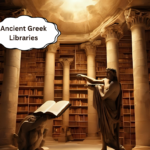The quest for knowledge of man began at the dawn of civilization. And with this quest for knowledge, its distribution also began in various forms, shapes, gestures, lines, and letters. The dissemination of knowledge continued in images and in various streams of history. The oldest writing found in the world was written about 5 thousand years ago. The means of distributing this knowledge have been preserved in various libraries for ages. And that is why libraries have been called the holders and carriers of civilization. In the course of time, this form has disappeared in many civilizations due to the lack of proper library preservation. Much of the history of human civilization has not been known due to the lack of preservation. What was known in the Library of Alexandria?
Background of the origin of the Library of Alexandria:
Only the reader of history knows how much the Greeks were true or not. The greatest achievement of the ancient era is their contribution to the Library of Alexandria. Around 331 BC, the ruler of Macedonia, Alexander the Great, conquered Egypt and Persia and founded the city of Alexandria in northern Egypt. Immediately after his death, his vast kingdom was divided among his generals, and thus the power of Egypt passed into the hands of King Ptolemy I.
Alexander’s general, Ptolemy I, ascended the throne in 305 BC,, and Alexander made it his capital. At that time, King Ptolemy I built a magnificent palace there that attracted scholars and scientists from the Greek world and neighboring countries. Ptolemy I was a tyrannical king, but he was admired by the people for his love of learning. With the help of scholars and wise men, Ptolemy built the ancient Library of Alexandria. It is the most discussed library of all time, the richest in the contemporary world, and the greatest in the ancient world. Alexandria is his contribution.

The structure of the Library of Alexandria:
In 307 BC, a scholar named “Demetrius,” who was released from death, took refuge in Egypt and gained the favor and prominence of Ptolemy I and devoted himself to Ptolemy. This scholar suggested establishing a school and a museum in Alexandria. His intention was that an educational institution and a library could immortalize a person, and even a good library could be purchased by future generations. Ptolemy accepted this proposal and established the Brucian Museum in Alexandria. In a short time, the museum became strong in terms of collection and was a true university for the scholarly class. He (Ptolemy) built a monastery, a hall, a reading room, an observatory, and a library in addition to the museum. The sole purpose of all this was to be a center for knowledge and learning. Here, various scholars were invited to their They were invited to translate books written in their mother tongue into Greek.
Features of the Library of Alexandria:
1. The librarians were famous scholars, poets, writers, scholars, grammarians, critics, etc. of that era;
2. Introduction of a well-organized system for collecting and using books;
3. Retrieving the text of written books;
4. Re-examining the text;
5. Reviewing the text
6. Editing the text;
7. Proper text layout;
8. Catalog of book titles, annotations, and short biographies of the authors
9. The catalog is a bibliography and biographical dictionary at the same time
10. Divided according to the past.
Collection of the Library of Alexandria:
When Emperor Alexander conquered Egypt and Persia and founded the city of Alexandria in northern Egypt, the Alexandria Library and Museum, one of the seven wonders of the world, was established, and for about 700 years, Alexandria was a universal treasury of knowledge. Emperor Ptolemy I collected books in Ethiopic, Persian, Hebrew, Latin, and other languages for this library, in addition to books written in Greek. The emperors of Egypt were very interested in enriching their libraries. For this reason, they did not hesitate to show arbitrariness.
During the Roman conquest of Egypt, the collection of manuscripts in Egyptian, Hebrew, Latin, and other languages was 700,000. In addition, the Seraphim, a library located in the temple of Serapis, had a collection of 100,000. Ulemais III Evergates (reigned 247–222 BC) decreed that books brought with them by tourists to Alexandria from abroad should be deposited in the library. If a book was not already in the library’s collection, it was left in the library. Owners were given copies of it, written on papyrus, at a cheap price.
It should be noted here that all the textual materials of the Library of Alexandria in Egypt were made of papyrus. The Library of Alexandria proceeded in a rather authoritarian manner with the help of the government of the time to enrich its collection.
Philadelphus’ contribution to the overall collection of the Library of Alexandria:
After the death of Ptolemy, his son Philadelphus left behind a collection that is rare even in this era. Under his generous patronage, the Library of Alexandria became the greatest library in the ancient world. He founded a small library in Egypt called the Pirapis Temple for ordinary citizens and students, which was a special part of the Library of Alexandria and was known as the “daughter library.” This Philadelphus made a law that if new books were found in Egypt by all foreigners who came to Alexandria, they should be arranged for the collection of this library by any means. In this way, the collection of both libraries reached about seven and a half million. Therefore, many people refer to Philadelphus as the real founder of the Library of Alexandria.
Catalogue of the Library of Alexandria:
As the collection of the Library of Alexandria gradually expanded from a single source to a vast one, the need for a catalogue arose. The director of this library, Callimachus (260 to 240 BC), compiled a complete catalogue of the works and collections of famous Greek literature. That is, he was the best cataloger and classifier of the Library of Alexandria. He divided all the libraries and collections into eight parts:
Which are as follows:
1. Playwright
2. Lawgiver
3. Historian
4. Rhetorician
5. Epic poet and lyricist
6. Philosopher
7. Orator
8. Writer on various subjects
Librarians/Officers of the Library of Alexandria:
The 12 respected scholars and intellectuals who were in charge of the Library of Alexandria from 290 to 247 BC were each called by historians the ideals of librarianship and the father of the library. Among them, the first official in charge of the museum or library, Demetrius, a worthy student of Aristotle, is particularly noteworthy. Whatever their professions and qualifications, no other library in the history of the West has gathered so many scholars and people with special knowledge as the Library of Alexandria.
The Library of Alexandria in the court of the world opened up knowledge:
The Library of Alexandria was the first to open the door to knowledge, science, and civilization to the whole world. It would not be unreasonable to say that the Library of Alexandria was previously limited to regional boundaries. But through this, it became universal. The light of knowledge and science spread around the world. The Library of Alexandria, which was prosperous and famous for almost 750 years, provided food for the human mind thirsty for knowledge, especially the knowledge of Greek culture, which was not possible for any other library in the world.
Criticism of the Library of Alexandria:
There are more criticisms than praises of service initiatives. The reason is that faults are easily noticed, not virtues, and Alexander was no exception. Many talented people/scholars did not hesitate to criticize this collection of manuscripts. They wanted to say that the then Library of Alexandria was helpful in spreading its influence with the intention of destroying the effectiveness of Greek culture and literature. They also wanted to say that Alexander could not only create new literature but also cling to the collection of old literature. Whereas, all those scholars should have selected and collected important works and influenced the creation of new literature.
The decline of the Library of Alexandria:
When Egypt, one of the centers of ancient civilization, began to decline in the second decade of the Christian era, the Library of Alexandria began to decline. By the end of the fourth century AD, the influence of paganism in Alexandria had diminished. The old and newly converted Christians considered the Library of Alexandria to be a center of atheism and immorality and hated it. Gradually, the importance of the library declined. Bishop Theo Kilus destroyed the library and part of it in Alexandria, the wonder of the world, in 390 AD. Moreover, in 47 AD, Julius Caesar’s conquest of Egypt was one of the reasons for the destruction of the Alexandria Museum and Library. Again, the capture of Alexandria by the Muslims caused great damage to the library.
Finally, it can only be said that the Egyptian government took the initiative to establish a new library to restore the Alexandria Library. For this, an international commission called “The International Commission for the Revival of the Ancient Library of Alexandria” was formed. Construction work began in the late 1990s at a cost of 160 million dollars, and operations were resumed in June 1995 with 200,000 new books and 1,000 periodicals. A ray of hope comes to the world court.



